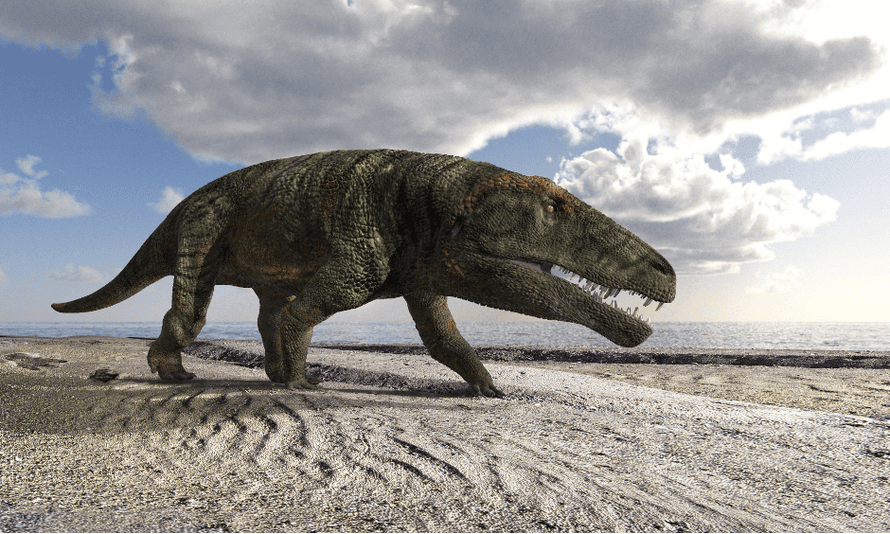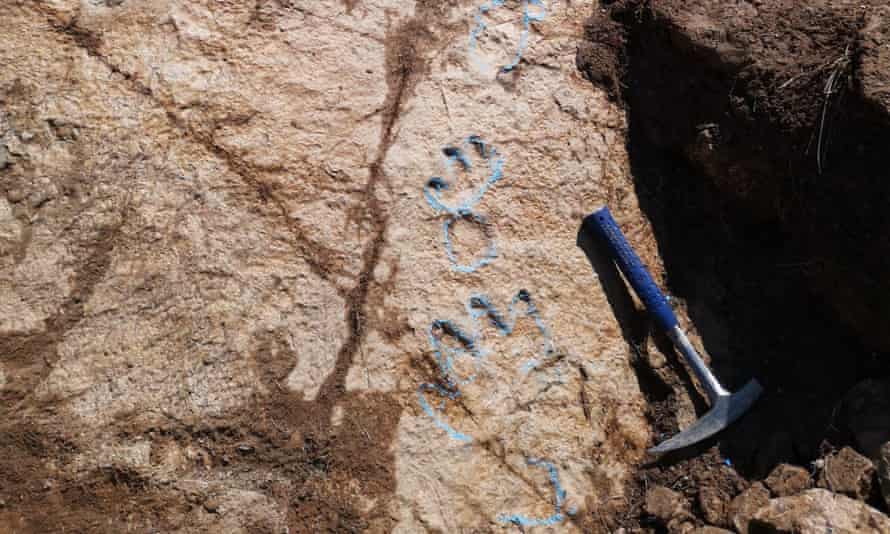Fossilised track dates back to period immediately following mass extinction 252m years ago

The reptile was hypothetically similar to a four-metre long crocodile.
Photograph: Trento Science Museum (MUSE).
Angela Giuffrida in Rome
Fri 15 Jan 2021 THE GUARDIAN
Footprints believed to have belonged to a crocodile-like prehistoric reptile have been found in the Italian Alps in an extraordinary discovery that scientists say proves there were survivors of a mass extinction 252m years ago.
The well-preserved fossilised track, made up of about 10 footprints, was found at an altitude of 2,200-metres in Altopiano della Gardetta, in the province of Cuneo in the western Alps.
The traces of front and rear claws, about 30cm in length, date back to about 250m years ago, after the area was rendered inhospitable by the mass extinction at the end of Permian geological period.
A team of palaeontologists and geologists at the Trento Science Museum (Muse), Zurich University’s Palaeontology Museum and the universities of Turin, Rome La Sapienza and Genoa were behind the discovery. Their study was published in Peer J, the biological, medical and environmental sciences journal.
From the size of the prints and distance between each one, the scientists concluded that they probably belonged to a reptile similar to a crocodile, at least 4 metre long, that had been walking along an ancient coastline near a river delta.
The first footprints were found in rocks in the area in 2008, with the scientists continuing their exploration over the following years until they had the complete set of prints needed to identify the animal.

Angela Giuffrida in Rome
Fri 15 Jan 2021 THE GUARDIAN
Footprints believed to have belonged to a crocodile-like prehistoric reptile have been found in the Italian Alps in an extraordinary discovery that scientists say proves there were survivors of a mass extinction 252m years ago.
The well-preserved fossilised track, made up of about 10 footprints, was found at an altitude of 2,200-metres in Altopiano della Gardetta, in the province of Cuneo in the western Alps.
The traces of front and rear claws, about 30cm in length, date back to about 250m years ago, after the area was rendered inhospitable by the mass extinction at the end of Permian geological period.
A team of palaeontologists and geologists at the Trento Science Museum (Muse), Zurich University’s Palaeontology Museum and the universities of Turin, Rome La Sapienza and Genoa were behind the discovery. Their study was published in Peer J, the biological, medical and environmental sciences journal.
From the size of the prints and distance between each one, the scientists concluded that they probably belonged to a reptile similar to a crocodile, at least 4 metre long, that had been walking along an ancient coastline near a river delta.
The first footprints were found in rocks in the area in 2008, with the scientists continuing their exploration over the following years until they had the complete set of prints needed to identify the animal.

Prints in the rocks in the Altopiano della Gardetta in the Italian western Alps.
Photograph: Trento Science Museum (MUSE).
“The fossil footprints were found in a kind of very wet sediment in which they could be preserved,” said Massimo Bernardi, a palaeontologist at Muse.
“You wouldn’t be surprised to find a trackway in the history of life, even if it is deep into the past. What is exceptional is the period in which the crocodile was walking in this place, because it was right after the mother of all mass extinctions.”
The extinction was provoked by a sudden rise in temperature, similar to what is happening to the planet today. It was previously believed that the area, which was in the equatorial belt, had become so inhospitable that the animals that survived must have migrated to other latitudes.
“A 4-metre large reptile gives proof that the whole ecosystem in one way or another was surviving because it couldn’t survive alone,” added Bernardi. “It wasn’t just walking around in the desert – it needed prey, and this prey needed plants, etc.”
Scientists can also use the variables to understand what the effects of the current climate crisis may be, Bernardi said.
“We are in a time of rapid climate change – of global warming, the aridisation of the equatorial belt and so on. And the fact we get surprised after finding evidence that someone survived, I think underlines how dramatic the impact of climate change is.”
“The fossil footprints were found in a kind of very wet sediment in which they could be preserved,” said Massimo Bernardi, a palaeontologist at Muse.
“You wouldn’t be surprised to find a trackway in the history of life, even if it is deep into the past. What is exceptional is the period in which the crocodile was walking in this place, because it was right after the mother of all mass extinctions.”
The extinction was provoked by a sudden rise in temperature, similar to what is happening to the planet today. It was previously believed that the area, which was in the equatorial belt, had become so inhospitable that the animals that survived must have migrated to other latitudes.
“A 4-metre large reptile gives proof that the whole ecosystem in one way or another was surviving because it couldn’t survive alone,” added Bernardi. “It wasn’t just walking around in the desert – it needed prey, and this prey needed plants, etc.”
Scientists can also use the variables to understand what the effects of the current climate crisis may be, Bernardi said.
“We are in a time of rapid climate change – of global warming, the aridisation of the equatorial belt and so on. And the fact we get surprised after finding evidence that someone survived, I think underlines how dramatic the impact of climate change is.”
No comments:
Post a Comment